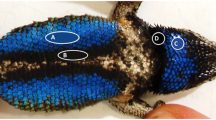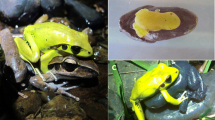Abstract
In some species, females develop bright colouration to signal reproductive status and exhibit behavioural repertoires to incite male courtship and/or reduce male harassment and forced copulation. Sex steroids, including progesterone and testosterone, potentially mediate female reproductive colouration and reproductive behaviour. We measured associations among plasma profiles of testosterone and progesterone with variation in colour expression and reproductive behaviour, including unique courtship rejection behaviours, in female Lake Eyre dragon lizards, (Ctenophorus maculosus). At onset of breeding, progesterone and testosterone increased with vitellogenesis, coincident with colour intensification and sexual receptivity, indicated by acceptance of copulations. As steroid levels peaked around the inferred ovulation time, maximal colour development occurred and sexual receptivity declined. When females were gravid and exhibited maximal mate rejection behaviours, progesterone levels remained consistently high, while testosterone exhibited a discrete second peak. At oviposition, significant declines in plasma steroid levels, fading of colouration and a dramatic decrease in male rejection behaviours co-occurred. Our results indicate a generally concordant association among steroid levels, colouration, behaviour and reproductive events. However, the prolonged elevation in progesterone and a second peak of testosterone was unrelated to reproductive state or further colour change, possibly suggesting selection on females to retain high steroid levels for inducing rejection behaviours.






Similar content being viewed by others
Abbreviations
- JND:
-
Just noticeable difference
- SE:
-
Standard error
- SD:
-
Standard deviation
- LWS:
-
Long wavelength sensitive
- GLMM:
-
General linear mixed model
- LSD:
-
Least squared difference
References
Amey AP, Whittier JM (2000) Seasonal patterns of plasma steroid hormones in males and females of the bearded dragon lizard, Pogona barbata. Gen Comp Endocrinol 117:335–342
Amundsen T (2000) Why are female birds ornamented? TREE 15:149–155
Amundsen T, Forsgren E (2001) Male mate choice selects for female coloration in a fish. Proc Natl Acad Sci USA 98:13155–13160
Amundsen T, Parn H (2006) Female coloration: a review of functional and non-functional hypotheses. In: Hill GE, McGraw KJ (eds) Bird coloration: function and evolution. Harvard University Press, Boston, pp 280–348
Arnqvist G, Rowe G (2005) Sexual conflict. Princeton University Press, Princeton
Baird TA (2004) Reproductive coloration in female collared lizards, Crotophytus collaris, stimulates courtship by males. Herpetologica 60:337–348
Barbour HR, Archer MA, Hart NS, Dunlop SA, Beazley LD, Shand J (2002) Retinal characteristics of the ornate dragon lizard, Ctenophorus ornatus. J Comp Neurol 450:334–344
Berger J (1983) Induced abortion and social factors in wild horses. Nature 303:59–61
Calisi RM, Hews DK (2007) Steroid correlates of multiple color traits in the spiny lizard, Sceloporus pyrocephalus. J Comp Physiol B 177:641–654
Chan SWC, Callard IP (1974) Reptilian ovarian steroidogenesis and influence of mammalian gonadotropins (follicle-stimulating hormone and luteinizing-hormone) in vitro. J Endocrinol 62:267–275
Chapman T, Arnqvist G, Bangham J, Rowe L (2003) Sexual conflict. TREE 18:41–47
Clutton- Brock TH, Parker GA (1995) Sexual coercion in animal societies. Anim Behav 49:1345–1365
Cooper WE, Clarke RF (1982) Steroidal induction of female reproductive coloration in the keeled earless lizard, Holbrookia propinqua. Herpetologica 38:425–429
Cooper WE, Crews D (1987) Hormonal induction of secondary sexual coloration and rejection behavior in female keeled earless lizards, Holbrookia propinqua. Anim Behav 35:1177–1187
Cooper WE, Crews D (1988) Sexual coloration, plasma concentrations of sex steroid hormones, and responses to courtship in the female keeled earless lizard (Holbrookia propinqua). Horm Behav 22:12–25
Cooper WE, Ferguson GW (1972a) Relative effectiveness of progesterone and testosterone as inductors of orange spotting in female collared lizards. Herpetologica 28:64–65
Cooper WE, Ferguson GW (1972b) Steroids and color change during gravidity in the lizard, Crotaphytus collaris. Gen Comp Endocrinol 18:69–72
Cooper WE, Greenberg N (1992) Reptilian coloration and behavior. In: Gans C, Crews D (eds) Hormones, brain, and behavior (biology of the reptilia, vol 18). University of Chicago Press, Chicago, pp 298–422
Cooper WE, Adams CS, Dobie JL (1983) Female color change in the keeled earless lizard, Holbrookia propinqua: relationship to the reproductive-cycle. Southwest Nat 28:275–280
Cox RM, Skelly SL, Leo A, John-Alder HB (2005) Testosterone regulates sexually dimorphic coloration in the Eastern Fence Lizard, Sceloporus undulatus. Copeia, 597–608
Cuadrado M (2000) Body colors indicate the reproductive status of female common chameleons: experimental evidence for the intersex communication function. Ethology 106:79–91
Dauphinvillemant C, Xavier F (1985) In vitro steroid biosynthesis by the adrenal gland of the female Lacerta vivipara Jacquin: the metabolism of exogenous precursors. Gen Comp Endocrinol 58:1–9
Desjardins JK, Hazelden MR, Van der Kraak GJ, Balshine S (2006) Male and female cooperatively breeding fish provide support for the “challenge hypothesis”. Behav Ecol 17:149–154
Farr JA (1980) Social behaviour patterns and determinants of reproductive success in the guppy, Poecilia reticulata Peters (Pisces: Poeciliidae): an experimental study of the effects of intermale competition, female choice and sexual selection. Behaviour 74:38–91
Fite JE, French JA, Patera KJ, Hopkins EC, Rukstalis M, Ross CN (2005) Elevated urinary testosterone excretion and decreased maternal care giving effort in marmosets when conception occurs during the period of infant dependence. Horm Behav 47:39–48
Folstad I, Karter A (1992) Parasites, bright males, and the immunocompetence handicap. Am Nat 139:603–622
Gill SA, Alfson ED, Hau M (2007) Context matters: female aggression and testosterone in a year-round territorial neotropical songbird (Thryothorus leucotis). Proc Roy Soc Lond B 274:2187–2194
Hegner RE, Wingfield JC (1986) Behavioral and endocrine correlates of multiple brooding in the semicolonial house sparrow Passer domesticus. II. Females. Horm Behav 20:313–326
Heinsohn R, Legge S, Endler JA (2005) Extreme reversed sexual dichromatism in a bird without sex role reversal. Science 309:617–619
Hemmi JM, Marshall J, Pix W, Vorobyev M, Zeil J (2006) The variable colours of the fiddler crab Uca vomeris and their relation to background and predation. J Exp Biol 209:4140–4153
Ketterson ED, Nolan V Jr, Sandell M (2005) Testosterone in females: mediator of adaptive traits, constraint on sexual dimorphism, or both? Am Nat 166:S85–S98
Kraaijeveld K, Gregurke J, Hall C, Komdeur J, Mulder RA (2004) Mutual ornamentation, sexual selection, and social dominance in the black swan. Behav Ecol 15:380–389
Langmore NE, Cockrem JF, Candy EJ (2002) Competition for male reproductive investment elevates testosterone levels in female dunnocks, Prunella modularis. Proc Roy Soc Lond B 269:2473–2478
Loew ER, Fleishman LJ, Foster RG, Provencio I (2002) Visual pigments and oil droplets in diurnal lizards: a comparative study of Caribbean anoles. J Exp Biol 205:927–938
Mank JE (2007) The evolution of sexually selected traits and antagonistic androgen expression in actinopterygiian fishes. Am Nat 169:142–149
McKinney F, Derrickson SR, Mineau P (1983) Forced copulation in waterfowl. Behaviour 86:250–294
McKinney F, Cheng KM, Bruggers DJ (1984) Sperm competition in apparently monogamous birds. In: Smith RL (ed) Sperm competition and the evolution of animal mating systems. Academic Press, Orlando, pp 523–545
McNicol JD, Crews D (1979) Estrogen/progesterone synergy in the control of female sexual receptivity in the lizard, Anolis carolinensis. Gen Comp Endocrinol 38:68–74
Medica PA, Turner FB, Smith DD (1973) Hormonal induction of color change in female leopard lizard, Crotaphytus wislizenii. Copeia 1973:658–661
Mitchell FJ (1973) Studies on the ecology of the agamid lizard Amphibolorus maculosus. Trans R Soc S Aust 97:47–76
Montgomerie R, Thornhill R (1989) Fertility advertisement in birds—a means of inciting male–male competition. Ethology 81:209–220
Nunn CL (1999) The evolution of exaggerated sexual swellings in primates and the graded-signal hypothesis. Anim Behav 58:229–246
Olsson M (1995a) Forced copulation and costly female resistance behavior in the Lake Eyre dragon, Ctenophorus maculosus. Herpetologica 51:19–24
Olsson M (1995b) Territoriality in Lake Eyre dragons Ctenophorus maculosus—are males superterritorial? Ethology 101:222–227
Olsson M, Wapstra E, Madsen T, Silverin B (2000) Testosterone, ticks and travels: a test of the immunocompetence-handicap hypothesis in free-ranging male sand lizards. Proc Roy Soc Lond B 267:2339–2343
Osorio D, Vorobyev M (2005) Photoreceptor spectral sensitivities in terrestrial animals: adaptations for luminance and colour vision. Proc Roy Soc Lond B 272:1745–1752
Quinn VS, Hews DK (2003) Positive relationship between abdominal coloration and dermal melanin density in phrynosomatid lizards. Copeia 2003:858–864
Renfree MB, Shaw G, Fletcher TP (1994) Evidence for the essential role of prostaglandins for parturition in a marsupial, Macropus eugenii. J Reprod Fert 102:433–446
Rhen T, Ross J, Crews D (1999) Effects of testosterone on sexual behavior and morphology in adult female leopard geckos, Eublepharis macularius. Horm Behav 36:119–128
Roulin A, Dijkstra C, Riols C, Ducrest AL (2001) Female- and male-specific signals of quality in the barn owl. J Evol Biol 14:255–266
Rowland WJ, Baube CL, Horan TT (1991) Signaling of sexual receptivity by pigmentation pattern in female sticklebacks. Anim Behav 42:243–249
Rubenstein DR, Wikelski M (2005) Steroid hormones and aggression in female Galapagos marine iguanas. Horm Behav 48:329–341
Rutowska J, Cichon M, Puerta M, Gil D (2005) Negative effects of elevated testosterone on female fecundity. Horm Behav 47:585–591
Salvador A, Veiga JP, Martin J, Lopez P (1997) Testosterone supplementation in subordinate, small male lizards: consequences for aggressiveness, color development, and parasite load. Behav Ecol 8:135–139
Searcy WA (1988) Do female red-winged blackbirds limit their own breeding densities? Ecology 69:85–95
Siddiqi A, Cronin TW, Loew ER, Vorobyev M, Summers K (2004) Interspecific and intraspecific views of color signals in the strawberry poison frog Dendrobates pumilio. J Exp Biol 207:2471–2485
Stuart-Fox D, Moussalli A (2008) Selection for social signalling drives the evolution of chameleon colour change. PLoS Biol 6(1):e25
Vorobyev M, Osorio D (1998) Receptor noise as a determinant of colour thresholds. Proc Roy Soc Lond B 265:351–358
Watkins GG (1997) Inter-sexual signalling and the functions of female coloration in the tropidurid lizard Microlophus occipitalis. Anim Behav 53:843–852
Watt MJ, Forster GL, Joss JMP (2003) Steroid correlates of territorial behavior in male jacky dragons, Amphibolurus muricatus. Brain Behav Evol 61:184–194
Weiss SL (2002) Reproductive signals of female lizards: pattern of trait expression and male response. Ethology 108:793–813
Weiss SL (2006) Female-specific color is a signal of quality in the striped plateau lizard (Sceloporus virgatus). Behav Ecol 17:726–732
Weiss SL, Jennings DH, Moore MC (2002) Effect of captivity in semi-natural enclosures on the reproductive endocrinology of female lizards. Gen Comp Endocrinol 128:238–246
Whiting MJ, Stuart-Fox DM, O’Connor D, Firth D, Bennett NC, Blomberg SP (2006) Ultraviolet signals ultra-aggression in a lizard. Anim Behav 72:353–363
Whittier JM, Tokarz RR (1992) Physiological regulation of sexual behavior in female reptiles. In: Gans C, Crews D (eds) Hormones, brain, and behavior (biology of the reptilia, vol 18). University of Chicago Press, Chicago, pp 24–69
Williamson P, Fletcher TP, Renfree MB (1990) Testicular development and maturation of the hypothalamic pituitary testicular axis in the male tammar, Macropus eugenii. J Reprod Fert 88:549–557
Wingfield JC, Hegner RE, Dufty AM Jr, Ball GF (1990) The “challenge hypothesis”: theoretical implications for patterns of testosterone secretion, mating systems, and breeding strategies. Am Nat 136:829–846
Wingfield JC, Lynn SE, Soma KK (2001) Avoiding the ‘costs’ of testosterone: ecological bases of hormone–behavior interactions. Brain Behav Evol 57:239–251
Woodley SK, Moore MC (1999a) Female territorial aggression and steroid hormones in mountain spiny lizards. Anim Behav 57:1083–1089
Woodley SK, Moore MC (1999b) Ovarian hormones influence territorial aggression in free-living female mountain spiny lizards. Horm Behav 35:205–214
Acknowledgments
We thank Adnan Moussalli for assistance in the field, Mats Olsson for advice and expertise through the course of the project and Cindy and Trevor Mitchell for their hospitality at Muloorina Station. Funding was from the Australian Research Council and the University of Melbourne. South Australian Department of Environment and Heritage permit to undertake scientific research S25421_1; Wildlife Ethics Committee approval 13/2007; University of Melbourne Animal Ethics Committee approval 0701400.1.
Author information
Authors and Affiliations
Corresponding author
Rights and permissions
About this article
Cite this article
Jessop, T.S., Chan, R. & Stuart-Fox, D. Sex steroid correlates of female-specific colouration, behaviour and reproductive state in Lake Eyre dragon lizards, Ctenophorus maculosus . J Comp Physiol A 195, 619–630 (2009). https://doi.org/10.1007/s00359-009-0437-4
Received:
Revised:
Accepted:
Published:
Issue Date:
DOI: https://doi.org/10.1007/s00359-009-0437-4




